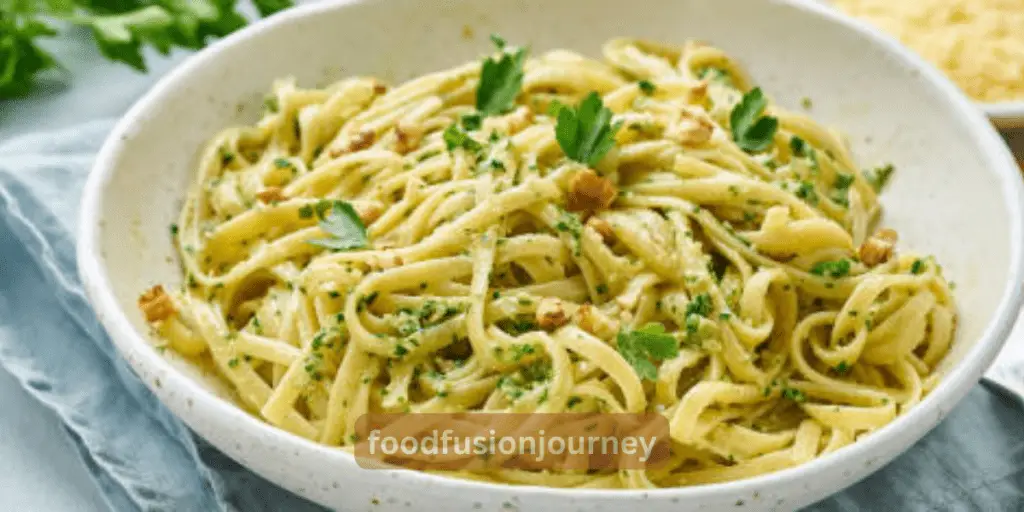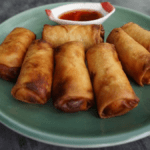Aglio e Olio recipe is a classic Italian pasta dish that translates to “garlic and oil.” It’s a simple and flavorful recipe that’s quick to make. Here’s how you can prepare (Aglio e Olio recipe) at home.
Ingredients for Aglio e Olio recipe
- 14 ounces (400g) spaghetti or any pasta of your choice
- 1/3 cup (80ml) extra-virgin olive oil for Aglio e Olio recipe
- 6-8 garlic cloves, thinly sliced for Aglio e Olio recipe
- 1/2 to 1 teaspoon red pepper flakes (adjust to your spice preference) for Aglio e Olio recipe
- 1/2 cup chopped fresh parsley for Aglio e Olio recipe
- Grated Parmesan cheese (optional)
- Salt and black pepper to taste
Instructions for Aglio e Olio Recipe
1/ Bring a large pot of salted water to a boil. Cook the pasta according to the package instructions until al dente (cooked but still firm to the bite). Reserve about 1 cup of the pasta cooking water before draining.
2/ While the pasta cooks, heat the olive oil in a large skillet over medium heat. Add the sliced garlic and red pepper flakes. Sauté them for about 1-2 minutes until the garlic becomes fragrant and just starts to turn golden. Be careful not to burn the garlic.
3/ Once the pasta is cooked, drain it, but do not rinse it. Add the drained pasta directly to the skillet with the garlic and oil.
4/ Toss the pasta well in the oil and garlic mixture, ensuring that each strand of pasta gets coated with the flavorful oil.
5/ If the pasta seems too dry, add a bit of the reserved pasta cooking water, a few tablespoons at a time, until you reach your desired consistency. The starchy pasta water helps create a silky sauce that clings to the pasta.
6/ Season the pasta with salt and freshly ground black pepper to taste. Add chopped parsley and toss again to combine everything.
7/ Serve the Aglio e Olio pasta hot, optionally topped with grated Parmesan cheese for an extra savory touch.
Enjoy your delicious and simple Aglio e Olio pasta! It’s a classic dish that never fails to impress with its robust flavors.
Tips and Tricks to Make a Delicious Aglio e Olio Recipe

- Pasta Selection: Choose good quality spaghetti or pasta of your choice. Cook the pasta until it’s al dente, which means it should still have a slight firmness when bitten.
- Salt the Pasta Water: Generously season the boiling water with salt before adding the pasta. This will enhance the pasta’s flavor as it absorbs the salt during cooking.
- Don’t Overcook Garlic: Be cautious not to overcook the sliced garlic in the olive oil. Garlic can burn quickly, which will result in a bitter taste. Cook it just until it turns golden and becomes fragrant.
- Use High-Quality Olive Oil: Since this recipe relies heavily on olive oil, use extra-virgin olive oil for the best flavor.
- Red Pepper Flakes: Adjust the amount of red pepper flakes to your preference for spiciness. Start with a smaller amount and add more if you like it hotter.
- Save Pasta Water: Before draining the pasta, reserve about a cup of the starchy pasta water. This water can be added to the sauce to create a silky texture and help the sauce cling better to the pasta.
- Tossing the Pasta: Combine the cooked pasta directly in the skillet with the garlic and oil. Toss the pasta well to ensure it’s evenly coated with the flavorful oil.
- Fresh Parsley: Chopped fresh parsley adds a burst of freshness to the dish. If possible, use flat-leaf Italian parsley for a more authentic touch.
- Experiment with Additions: While the traditional Aglio e Olio is simple, you can get creative by adding ingredients like sautéed mushrooms, cherry tomatoes, shrimp, or even grated cheese.
- Serve Immediately: Aglio e Olio is best when served fresh and hot. Avoid letting it sit too long before serving to maintain its ideal texture and flavor.
By following these tips and tricks, you’ll be able to create a mouthwatering Aglio e Olio recipe with pasta that will impress your family and friends with its wonderful flavors.
NUTRITION FACTS

Nutrition Facts for One Serving: (Aglio e Olio Recipe)
Calories: 350-400 kcal (depending on the type of pasta used)
Total Fat: 14-16 grams
Saturated Fat: 2-3 grams
Monounsaturated Fat (from olive oil): 10-12 grams
Sodium: 0-400 milligrams (depending on added salt)
Total Carbohydrates: 46-50 grams
Dietary Fiber: 2-3 grams
Sugars: 1 gram
Protein: 7-9 grams
Please note that these nutrition facts are approximate and can vary based on the type and brand of pasta and the amount of olive oil used. Additionally, the serving size may vary depending on your preference.
Aglio e Olio is relatively low in calories and can be a part of a balanced diet. However, the amount of olive oil used can significantly impact the calorie and fat content, so you can adjust it to your dietary preferences. Enjoy your delicious homemade Aglio e Olio Recipe!






